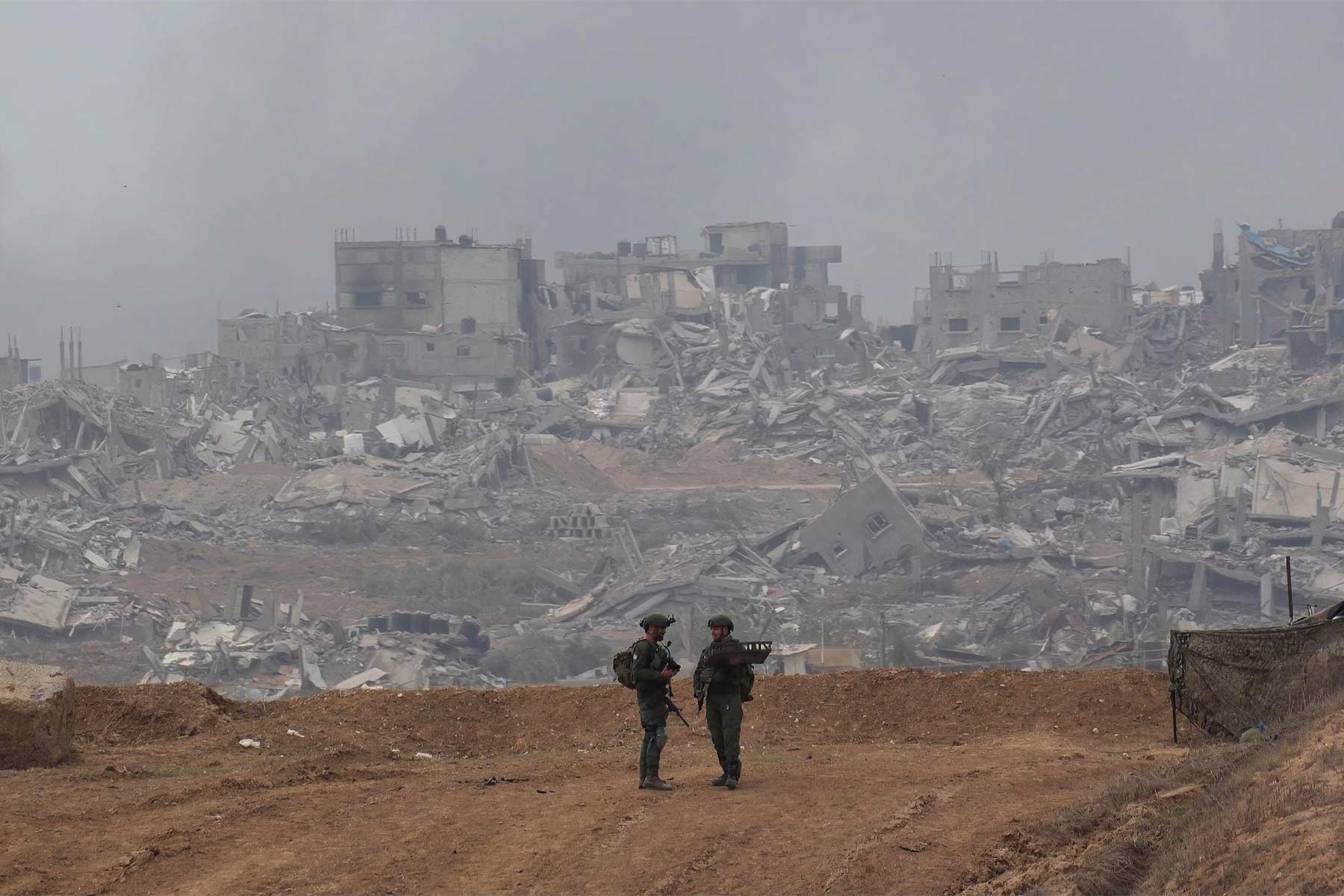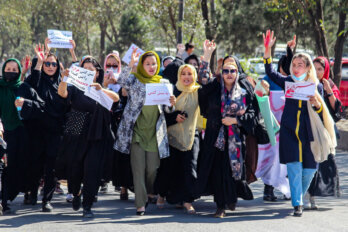Israel’s war on Gaza is a consequence multiplier. Every day brings horrific new after-effects—both regional and geopolitical—that have to be added to an ever-ramifying, ultimately unknown, outcome. Few experts can speak to the complexity of what is happening and may yet happen. Jon Allen is one of them. Canada’s ambassador to Israel from 2006 to 2010, he is currently a senior fellow at the Munk School of Global Affairs and Public Policy at the University of Toronto and a distinguished fellow of the Canada International Council. In one role or another—as a diplomat, intellectual, and policy maker—he has been studying, researching, and thinking about the Middle East for much of his adult life. We recently spoke by email about the more strategic aspects of Israel’s military operation and where he believes events might end up.
Vowing to destroy Hamas following its October 7 massacre, Israel has laid waste to much of the Gaza Strip. The damage staggers: an estimated tens of thousands of Palestinians have been killed in bombing raids reportedly more intense than what we’ve seen in Ukraine, Syria, or even World War II. Yet Hamas still stands. In some ways, critics argue, Israeli operations have strengthened Hamas’s hand by reconfirming its legitimacy, among some, as a check on Israel. Did the Israel Defense Forces underestimate Hamas?
Despite warnings from the Americans to take previous US failures into account before the ground offensive began, and despite the IDF’s previous experiences in Gaza where rooting out Hamas had proved difficult, Israel went in with full force, dropping massive bombs and employing looser rules of engagement than in past conflicts with Hamas. They did it because they were humiliated and devastated by Hamas’s horrific attack. They did it because Israelis wanted revenge and to regain a sense of security. They convinced themselves that Israelis wouldn’t return to the south unless Hamas had been eliminated from Gaza. They likely convinced themselves that by destroying north and central Gaza, including the tunnel infrastructure which is so key to Hamas’ defences, they could kill and/or capture the major Hamas political and military leaders who remained in the Strip, and that they could do serious damage to many of the Hamas battalions in the process.
They did underestimate Hamas, and the IDF has already admitted that the mission is more difficult and taking longer than they expected. Indeed, three months into the war, Israel has been unable to assassinate even one of the three main Hamas leaders believed to be in Gaza. While they would have anticipated the criticism from the Middle East and the Global South more generally, they likely did not expect the almost universal demands for either humanitarian pauses or a full ceasefire that the carnage they have caused has generated. Because it is taking so long and because of the massive death and injury toll, Hamas has also won the political and ideological battle, both amongst Palestinians in the West Bank and among a largely younger demographic worldwide, including in North America and Europe.
What does winning that “political and ideological battle” look like for Hamas? Can you describe the current state of the debate around the military operation as you see it?
For Hamas, which knows it cannot win militarily against Israel, winning means putting the Palestinian issue back on the front burner in Israel and the front pages in Israel and worldwide. The ongoing and growing criticism of Israel in the Western media, the massive pro-Palestinian demonstrations, and the votes in the UN calling for a ceasefire are all victories for Hamas.
The current state of the debate around Israel’s military actions in Gaza centres on a couple of different issues. One is whether the goals—destroying Hamas, freeing the hostages, and convincing Israelis to return to their homes in the south and in the north, close to the Lebanese border—are achievable. Destroying all of the 30,000 to 40,000 militants and their ideology is clearly not achievable, so the question becomes how many leaders and how many militants need to be killed before Israel declares victory. Freeing the remaining hostages and continuing to pursue the Hamas leadership may be contradictory goals. At a minimum, a pause will be required. In early January, Hamas refused to negotiate a hostage release/exchange unless Israel agrees to a complete ceasefire. For some Israelis, the hostages should be priority number one. For the far-right members of Israel’s coalition government, eliminating Hamas is paramount.
Then there is the question of the nature of the continuing Israeli military actions and the speed at which they will adopt a more strategic, targeted approach that minimizes or at least reduces the number of innocents being affected and focuses on the Hamas leadership.
As mentioned, Israel’s progress has been slower than expected. Very few of the most prominent leaders have yet been killed. The number of IDF soldiers killed and seriously wounded is mounting. There have, no doubt, been IDF successes. The military estimates, for example, that some 9,000 Hamas fighters have been killed and infrastructure has been destroyed, but despite what Benjamin Netanyahu has to say, I doubt that this war will continue at this level for months to come.
In your estimation, why has Hamas been so difficult to root out?
It appears that Hamas had been planning this attack and its defence against the inevitable Israeli response for years. The extensive tunnel system that Hamas has created over the years is nicknamed “the Metro” because of how complex and deep it is. The tunnels allow Hamas operatives to move undetected throughout the Gaza Strip and pop up in unexpected locations. Hamas is able to store weapons and ammunition in the tunnels and has reportedly received sophisticated weapon systems from Iran and Hezbollah. It has also laid anti-personnel land mines and various other booby traps which make Israeli advances difficult and dangerous.
Hamas knows the terrain intimately. The IDF does not. Hamas is seemingly undeterred by the fact that thousands of innocent Palestinians have been killed and injured. When asked by journalists why, for all the tunnels they dug for themselves, Hamas never built bomb shelters for civilians, a spokesperson replied that the tunnels were for Hamas and that “it is the responsibility of the UN” to look after civilians.
Finally, the hostages complicate Israel’s efforts to eliminate Hamas leadership. It is likely that some hostages are providing the ultimate human shield for Israel’s most wanted Hamas chiefs.
There are fears that Israel is seizing the moment to trigger a second Nakba, or mass displacement. Several of the country’s lawmakers have made comments appearing to support it. Does the accusation have merit?
As much as most Israelis would probably support an exit of all Palestinians from Gaza (and probably the West Bank), only the most far-right members of the current coalition and far-right journalists have advocated such an outcome. It is not difficult to understand where such accusations against Israel come from when the IDF orders Gazans to move to the south of the Strip for safety and then begins bombing, thereby forcing hundreds of thousands of refugees farther south toward the Rafah crossing with Egypt.
It’s important to note that statements by government ministers, members of the legislature, and senior officials supporting such a mass displacement (even if not government policy) will be used against Israel in any efforts to bring the country before the International Court of Justice and the International Criminal Court, where Israel and/or some of its leadership could be accused of genocide, war crimes, and crimes against humanity. Indeed, South Africa has already brought such a case against Israel at the ICJ, alleging genocide by the IDF.
With Hamas likely surviving the war in some form, do you believe Israel’s calculus around its military operation is changing? What is the post-war future for Gaza?
For now, Israel will continue to pursue the Hamas leadership both within and outside Gaza—note the recent assassination of Hamas leader Saleh al-Arouri in Beirut. It will do everything possible to destroy Hamas’s infrastructure, especially the tunnels from which it so effectively operates. It has already captured a significant amount of Hamas weapons and the machinery required to produce weapons and rockets.
Israel’s overall strategy is already starting to evolve, with the IDF beginning to bow to US pressure and implement a more targeted approach, although the number of Gazan deaths and injuries remains unacceptably high. Israel has also begun to withdraw some of its reservists to allow these men and women to return to university and the workforce.
The post-war future for Gaza will involve a rebuilding and massive supply of humanitarian aid by some form of international grouping that will include the UN system, the US, the EU, and others. Hopefully, the Gulf states will contribute a significant amount of funding. Once the threat from a counterinsurgency has been dealt with—no easy task—some form of international governance system will begin to operate. It will not be under full UN control, as Israel would be opposed, but it will hopefully include international organizations as well as certain countries providing technical assistance. It will be important to demonstrate to Gazans that a Hamas replacement can be a better supplier of food, social services, education, and health services than Hamas was. There is talk of including members of the most important families in Gaza as a key part of this governance system.
Is there anything about this current situation that has surprised you? What has been the biggest takeaway from the events that have unfolded?
There are many aspects of the events of October 7 and following that have surprised me. First, the horrific nature of the attack, including the sexual assaults, the murders of innocent women, children, and the elderly, and much more. The tragic irony of this attack is that many of the kibbutzniks living along the border were peace activists. For example, Vivian Silver, a Canadian Israeli whom my wife and I knew well and who devoted her life to improving relations between Arab Israelis and Jewish Israelis and between Israelis and Palestinians, was one of those killed on October 7.
Second, the absolute failure of the massive intelligence resources at Israel’s disposal and the equally disturbing failure of the IDF to have sufficient forces in the region and to respond quickly to the attack.
Third, the extent of the cynicism and the manipulation of Netanyahu in his dealings with Hamas, on the one hand, and the Palestinian Authority, on the other, was also shocking and has fully been exposed only now. Bibi supported Hamas and knowingly allowed it to grow, weaponize, and build its infrastructure. At the same time, he was denigrating the PA, which was protecting Israelis from terrorist attacks from the West Bank and working hand in hand with Israeli security services. This enabled him to convince the Israeli public that there was no partner for peace, a refrain I have been listening to for over a decade and which the establishment diaspora community and most Israelis believe and preach. So, instead of creating a political horizon for peace and encouraging Palestinians who were willing to engage with Israel, Bibi encouraged settlement construction, allowed illegal settlements to multiply, and ultimately formed a government with the most right-wing and racist parties ever to govern the country. The coalition agreement Bibi signed with these parties actually calls for the annexation of the West Bank that would effectively put to rest the idea of two states for two peoples.
Fourth, perhaps most surprising to me—and in retrospect, it shouldn’t have been—was the effect of the attack, and the failure of the government to effectively respond to it, on all Israelis. They have been gutted, humiliated, and paralyzed emotionally by the events of October 7. Their contract with their government was broken, they have become fearful, and they saw and still see the war in Gaza, the elimination of Hamas, and the return of the hostages as the only way, at least in the short term, to begin to heal and move on.
Israelis—with whom I have worked for years on ending the occupation, stopping the settlements, and supporting a two-state solution—were, at least initially, in favour of a massive ground invasion irrespective of the cost to innocent Palestinians. They and their leaders were unwilling to listen to the advice of Joe Biden and many others who, based on recent experiences in Iraq, Afghanistan, and fighting ISIS, cautioned Israel that a massive response like the one they have engaged in will not be able to achieve its goals, will only radicalize Palestinians and their supporters, and will allow Hamas to declare a public relations victory. Most Israelis seem ambivalent about the horrific tragedy taking place in Gaza. They blame Hamas, not the IDF, for the death and injury toll, accusing Hamas, correctly, of using civilians as human shields. This is beginning to change, but the vast majority of Israelis watch and listen only to Israeli media, which is partially censored, extremely biased, and does not show the kinds of pictures of dead and dying innocent Palestinians that we in the rest of the world see every day and night.
Fifth, I would say that the extent of support, both military and emotional, that the US government in general and the president in particular provided Israel was unprecedented. This included a strike force in the Mediterranean, a presidential visit days after the attack, massive supplies of weapons and ammunition, and continuing support despite the obvious differences between the US government’s and Netanyahu’s visions of the way forward. Indeed, the president is already paying a significant price in the polls, especially among young Democrats who oppose his continuing, almost unqualified support for Israel.
A difficult question, perhaps, but do you have any hope for the future?
What allows me to continue to be hopeful about the eventual outcome of this tragedy and previous conflicts before it is the revival of the realization that the two-state solution is the only way forward if these two people are going to be able to live in peace and security. Obviously, this is not a time when either Israelis or many Palestinians are even willing to contemplate two states. But it is important that Western governments have finally woken up to the fact that their past acquiescence in Israeli settlement expansion, land theft, and violence against Palestinians has only brought instability to the region and injustice to Palestinians. They and former Israeli leaders, like Ehud Olmet, Ehud Barak, and Tzipi Livni, and hundreds of ex Israeli generals and heads of the IDF, Mossad, and the Shin Bet (Israel’s domestic security service) understand that creating a horizon for peace, stopping the settlement expansion, and supporting international efforts to improve PA governance is the only way forward. The bottom line is that neither of these two peoples is going anywhere, so they must learn how to share the land. Two separate states is the only option given the lack of trust that currently exists. Over time, they can perhaps move toward a friendly divorce.




